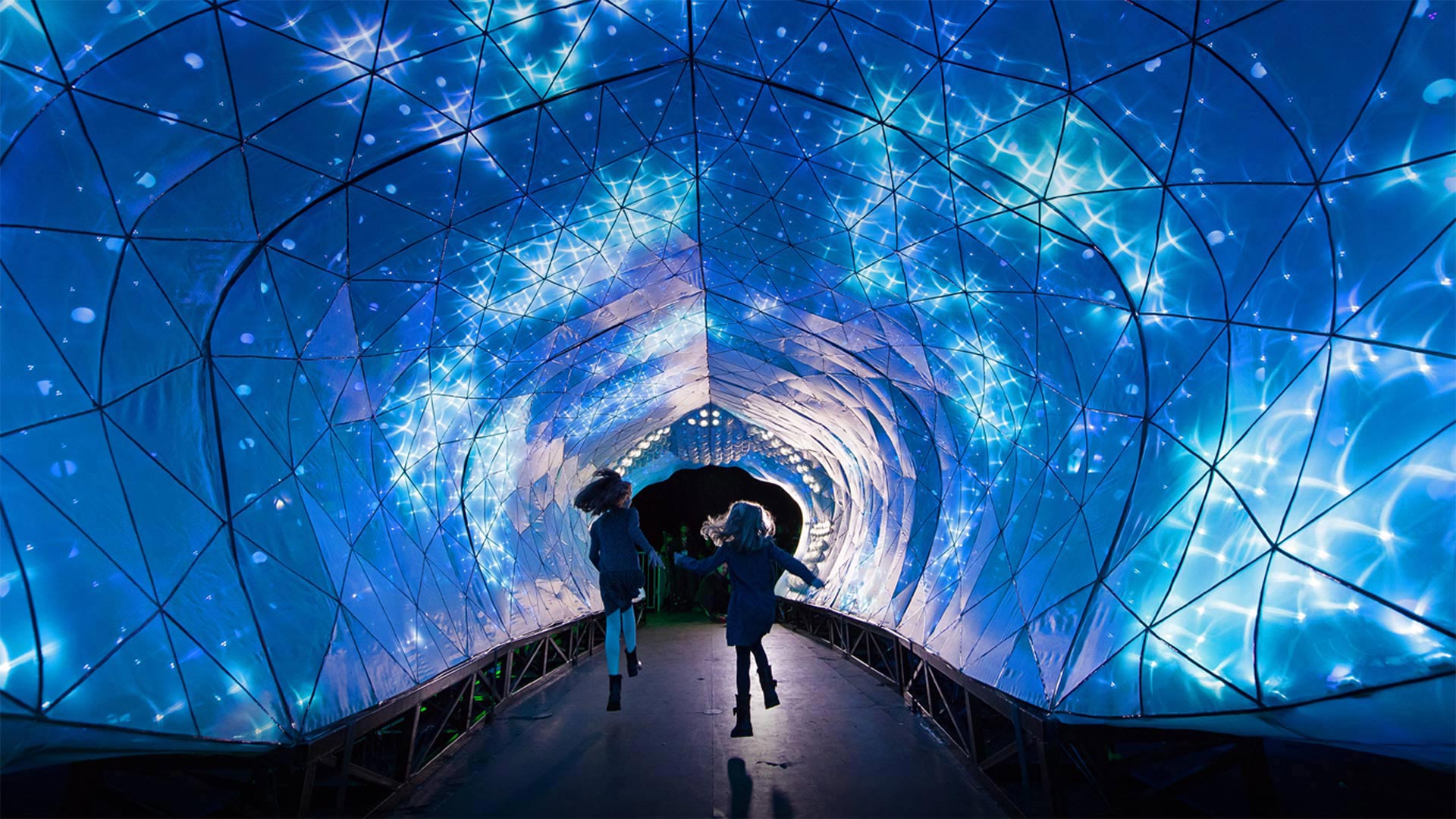PCA 人脸识别 | 字数总计: 2.7k | 阅读时长: 11分钟 | 阅读量:
PCA(Principal Component Analysis) 作为一种数学矩阵分析方法,能够约简多元数据集,在许多领域有重要应用,本篇介绍 PCA 应用于人脸识别。
问题 给定一组具有 $m$ 个样本的 $n$ 维数据 ${a_1, a_2, \cdots, a_m }$,如何找到特殊的较少方向使得数据在该方向上的投影方差最大。方差大说明在新空间中数据更容易分离,更方便判断类别等。
理论 将每个样本写成列向量,得到矩阵:
$$
A = \bigl(
\begin{smallmatrix}
a_1 & a_2 & \cdots & a_m
\end{smallmatrix}
\bigr)
$$
为了方便,我们先对矩阵 $A$ 沿着行方向求取平均值,然后将 $A$ 的每一行减去对应的均值。这样做能够约简 $A$,方便计算。
寻找主方向 $u$,使得 $A$ 在该方向的投影方差尽量大,方差最大的方向就是主方向。即
$$
Var(A \cdot u) = (Au)^T(Au) = u^T A^T Au.
$$
为目标函数。一般地,我们选择单位方向 $u$,所以有 $u^Tu=1$.
利用 Lagrange 乘子法求解如下方程:
$$
L(u) = u^TA^TAu + \lambda(u^Tu-1).
$$
对单位方向 $u$ 求方向导数,并令其为0,得到
$$
A^TAu = -\lambda u.
$$
从上式可以看出,PCA 选择的方向其实就是方阵 $A^TA$ 的特征向量方向,按照特征值从大到小排序得到对应的特征向量方向,就是 PCA 选择的按照重要度排序的方向。
PCA 人脸识别 利用 PCA 进行人脸识别。 将人脸图像转化为灰度图像,对所有人脸图像进行 PCA 投影到新空间(一般称为脸空间)。对每一个人的人脸图像计算投影在脸空间中的平均坐标。当新人脸识别时,先投影到脸空间,然后计算投影坐标距离已知的人脸平均坐标的最小值,该最小值对应的人脸即为识别到的人脸。
步骤:
把每一幅图像转化为灰度图(图像宽、高分别是 $w,h$),然后拉长为一维列向量,分别取每个人的人脸图像 $k$ 副,剩余 1 副留作验证。**依次(同一个人的脸图像挨着)**作为列向量组成一个矩阵 $A_{r\times c} = \bigl(
\begin{smallmatrix}
a_1 & a_2 & \cdots & a_{km}
\end{smallmatrix}
\bigr), r = w*h, c=k*m$ ,每一个 $a_i, i=1,2,\cdots, km$ 为一个人脸列向量;
对矩阵 $A_{r\times c}$ 的每一行求取平均值,得到的均值向量即为 $a_{mean}$,然后每一行减去对应的均值。即对 $A_{r\times c}$ 取中心化,这里仍记作 $A_{r \times c}$;
计算协方差矩阵,这里约简为均值相乘: $\text{Corr}_{c\times c} = A^T_{r \times c} \cdot A_{r \times c}$;
计算矩阵 $\text{Corr}_{c\times c}$ 的特征值向量 $eigvalue_{c\times 1}$ 和特征向量矩阵 $EigVec_{c\times c}$,假设每一列为一个特征向量;
对特征值按照从大到小排序,并筛选前 90%(为阈值。前 $n$ 个特征值和正好占总特征向量和的比超过 90%,根据情况选择该阈值) 的特征值对应的特征向量矩阵
$EigVec^{thres}_{c \times n} = \bigl(\begin{smallmatrix}
EigVec^1_{c\times 1} & EigVec^2_{c \times 1} & \cdots & EigVec^n_{c \times 1}
\end{smallmatrix}
\bigr)$
;
计算特征脸矩阵
$B_{r \times n} = A_{r\times c} \cdot EigVec^{thres}_{c\times n} = \bigl(
\begin{smallmatrix}
A_{r\times c}\cdot EigVec^1_{c\times 1} & A_{r\times c} \cdot EigVec^2_{c\times 1} & \cdots & A_{r\times c} \cdot EigVec^n_{c\times 1}
\end{smallmatrix}
\bigr)$
,
将矩阵 $A_{r \times c}$ 投影到脸空间 $B_{r \times n}$ 得到脸特征矩阵,即
$$P_{c \times n} = A^T_{r\times c} \cdot B_{r\times n} =
\left[
\begin{array}{cc|c}
p_1 \\
p_2 \\
\vdots \\
p_n
\end{array}
\right]
$$
,
其中每一行对应一个脸向量在脸空间中的坐标。因为前面我们是依次(同一个人的脸图像挨着)构建矩阵 $A_{r\times c}$ 的,所以,我们可以对脸特征矩阵 $P_{c \times n}, c=k*m$ 的每 $k$ 行计算平均,得到 $m$ 个人在的脸在脸空间中的位置坐标(领域),记作
$
P_{mean} = \bigl(\begin{smallmatrix}
p^1_{mean} & p^2_{mean} & \cdots & p^m_{mean}
\end{smallmatrix}
\bigr)
$
,每个 $p^i_{mean}$ 都是 $1\times n$ 维的;
对于新来的人脸图像进行识别。首先将人脸图像灰度化,然后拉长为一维列向量 $b_{r\times 1}$,(对应位置)减去均值向量 $a_{mean}$,得到向量 $c_{r\times 1} = b_{r\times 1} - a_{mean}$,然后将向量 $c_{r\times 1}$ 投影到脸空间 $B_{r\times n}$,即 $p_{1\times n} = c^T_{r\times 1} \cdot B_{r\times n}$。最后计算 $p_{1\times n}$ 距离 $p^i_{mean}$ 哪个最近,就说明是那个人的脸。
实现 环境配置 如下命令在终端中执行(以 Ubuntu 18.04 为例):
1 2 3 4 5 6 7 8 9 10 11 12 13 14 15 16 wget https://repo.anaconda.com/miniconda/Miniconda3-latest-Linux-x86_64.sh chmod +x Miniconda3-latest-Linux-x86_64.sh/bin/bash Miniconda3-latest-Linux-x86_64.sh -b -p ~/miniconda conda init source ~/.bashrcconda create -n maths-ai python=3.11 -y conda activate maths-ai pip install ipykernel ipywidgets python -m ipykernel install --user --name maths-ai --display-name maths-ai pip install opencv-python pillow numpy matplotlib scipy sympy pip install torch==2.2.1 torchvision==0.17.1 torchaudio==2.2.1 --index-url https://download.pytorch.org/whl/cu118
安装完成后,打开 jupyter 继续执行如下命令
下载数据 访问链接 github ,git clone https://github.com/hsahuja111/Face-Recognition-using-Principal-Component-Analysis.git
下载后图像存放在 ATnT 中。
参考链接:
数据检查 1 2 3 import osfrom PIL import Image
1 data_path = "/disk1/datasets/maths-ai/face-recognition/ATnT/"
1 2 3 4 5 6 batch = 9 face_d = {} for file in os.listdir(data_path): file_path = os.path.join(data_path, file) if os.path.isdir(file_path): face_d[file] = sorted (os.listdir(file_path), key=lambda x: int (x.split("." )[0 ]))
('共多少种人脸?', 40)
加载包 1 2 3 4 5 6 import osimport cv2import matplotlib.pyplot as pltimport numpy as npfrom PIL import Image
构建矩阵 1 2 3 4 5 6 7 8 9 10 11 12 13 14 15 16 17 18 19 20 21 22 23 w = 92 h = 112 def img_to_vector (img_path ): """ 把图像转化为灰度图,然后转化为一维向量 """ img = cv2.imread(img_path) img_gray = cv2.cvtColor(img, cv2.COLOR_BGR2GRAY) return img_gray.reshape(-1 ) keys_face = sorted (list (face_d.keys())) name = keys_face[0 ] img_path = os.path.join(data_path, name, face_d[name][0 ]) img_vector = img_to_vector(img_path=img_path) plt.imshow(img_vector.reshape(h, w), cmap="gray" ) plt.title(name) plt.show()
1 2 3 4 5 6 7 8 9 10 11 12 A = None for k in keys_face: v = face_d[k] for i in range (batch): img_path = os.path.join(data_path, k, v[i]) img_vector = img_to_vector(img_path).reshape(-1 , 1 ) if A is None : A = img_vector else : A = np.hstack((A, img_vector)) A.shape
(10304, 360)
1 avg_face_vector = A.mean(axis=1 )
1 2 3 4 avg_face = avg_face_vector.reshape(h, w) plt.imshow(avg_face, cmap="gray" ) plt.title("avg face" ) plt.show()
1 A_homo = A - avg_face_vector.reshape(-1 , 1 )
1 2 3 4 5 6 7 8 9 10 11 12 13 14 15 16 17 fig, ax = plt.subplots(2 , 5 ) plt.rc("font" , size=13 ) fig.set_figwidth(25 ) fig.set_figheight(10 ) for i in range (10 ): ind = i * batch + 1 ai = A_homo[:, ind] name = keys_face[i] ai_image = ai.reshape(h, w) r = i // 5 c = i % 5 ax[r][c].imshow(ai_image, cmap="gray" ) ax[r][c].set_title(f"{name} " ) ax[r][c].xaxis.set_major_locator(plt.NullLocator()) ax[r][c].yaxis.set_major_locator(plt.NullLocator()) plt.show()
计算协方差阵的特征向量,选择主特征 1 2 3 Cov_A = np.matmul(A_homo.transpose(), A_homo) Cov_A.shape
(360, 360)
1 eig_values, eig_vectors = np.linalg.eig(Cov_A)
1 2 3 eig_values_sorted_index = np.argsort(-eig_values) eig_values_sorted = np.sort(eig_values)[::-1 ]
1 2 plt.plot(range (len (eig_values_sorted)), list (eig_values_sorted)) plt.show()
1 2 eig_vectors_sorted_by_values = eig_vectors[:, eig_values_sorted_index]
1 2 3 4 5 6 7 8 9 eig_acc = 0 total_eig = np.sum (eig_values) for i, eig in enumerate (eig_values_sorted): eig_acc += eig if eig_acc / total_eig >= 0.9 : threshold = i break threshold
103
1 2 3 eig_vectors_selected = eig_vectors_sorted_by_values[:, :threshold] eig_vectors_selected.shape
(360, 103)
计算特征脸 (10304, 360)
1 2 3 B = np.matmul(A_homo, eig_vectors_selected) B.shape
(10304, 103)
1 2 3 4 5 6 7 8 9 10 11 12 13 14 15 16 17 fig, ax = plt.subplots(2 , 5 ) plt.rc("font" , size=13 ) fig.set_figwidth(25 ) fig.set_figheight(10 ) for i in range (10 ): eig_face = B[:, i] eig_value = eig_values_sorted[i] eig_face_image = eig_face.reshape(h, w) r = i // 5 c = i % 5 ax[r][c].imshow(eig_face_image, cmap="gray" ) ax[r][c].set_title(f"{i} -th eig-face" ) ax[r][c].xaxis.set_major_locator(plt.NullLocator()) ax[r][c].yaxis.set_major_locator(plt.NullLocator()) plt.show()
计算投影空间 1 2 3 4 P = np.matmul(A.transpose(), B) P.shape
(360, 103)
识别人脸 1 2 3 4 name = keys_face[2 ] img_name = face_d[name][-1 ] img_name
'10.pgm'
1 2 3 4 5 6 img_path = os.path.join(data_path, name, img_name) img_vector = img_to_vector(img_path=img_path) img_vector_norm = img_vector - avg_face_vector img_vector_norm = img_vector_norm.reshape(-1 , 1 ) img_vector_norm.shape
(10304, 1)
1 2 3 plt.imshow(img_vector_norm.reshape(h, w), cmap="gray" ) plt.show()
(10304, 103)
(10304, 1)
1 2 3 project_vector = np.matmul(img_vector_norm.reshape(1 , -1 ), B) project_vector.shape
(1, 103)
(360, 103)
1 2 3 4 5 6 7 P_avg = [] for i in range (P.shape[1 ] // batch): P_slice = P[i * batch : (i + 1 ) * batch, :] P_avg.append(P_slice.mean(axis=0 )) len (P_avg)
11
(103,)
1 2 3 ind = np.argmin(np.sum ((np.array(P_avg) - project_vector.reshape(1 , -1 )) ** 2 , axis=1 )) ind
2
1 2 3 pred_name = keys_face[ind] pred_name
's11'
1 2 3 4 5 6 7 8 9 10 11 12 img = cv2.imread(img_path) pred_img = cv2.imread( os.path.join(data_path, pred_name, face_d[pred_name][0 ]) ) fig, ax = plt.subplots(1 , 2 ) ax[0 ].imshow(img[..., ::-1 ]) ax[0 ].set_title(f"truth name:{name} " ) ax[1 ].imshow(pred_img[..., ::-1 ]) ax[1 ].set_title(f"predict name:{pred_name} " ) plt.show()
根据图像和预测的人脸name可以判断识别正确
优缺点
PCA 是一种线性投影方法,对于线性不可分的情况处理效果不好;
可能损失有用的信息;















